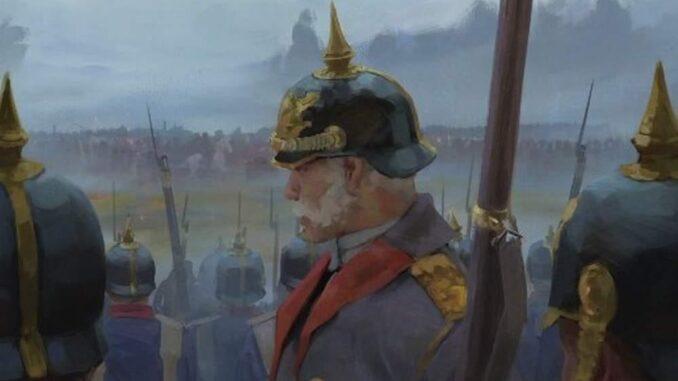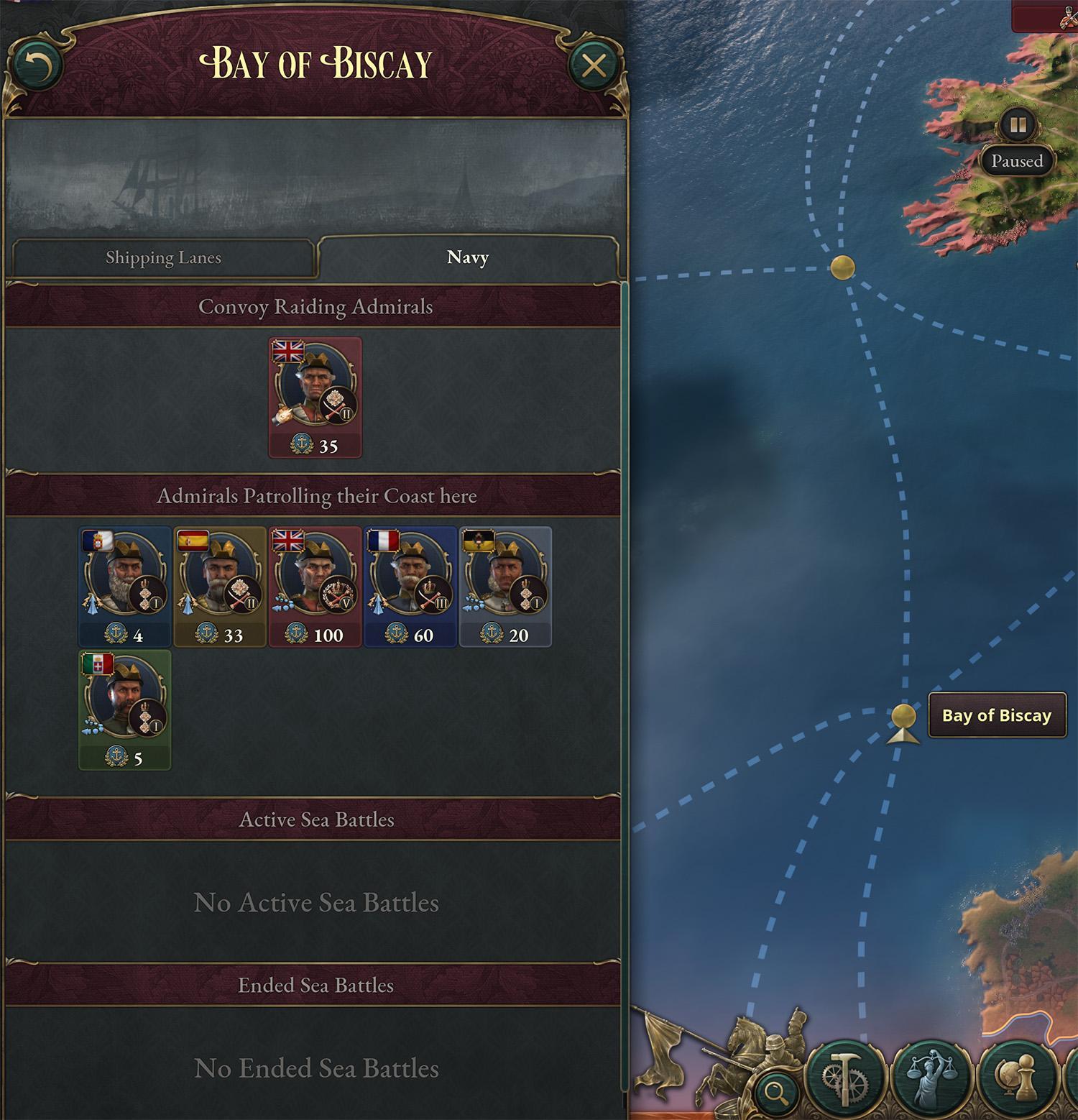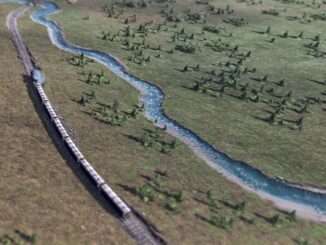
In Victoria 3, overseas trade is vital to many nations, while in times of war, supply is sent via the nation’s supply network, and invasions can be mounted and may need to be defended against. Admirals, commanding flotillas, are the means by which countries defend their sea lines of communication while projecting power themselves.
A French patrolling fleet has caught a British fleet assigned to raid convoys in the Bay of Biscay. Note the low starting morale of the British fleet (it was still recovering from an earlier battle).

Admirals also have orders like generals but, unlike generals, there are no fronts in the sea. Rather, each order will relate, directly or indirectly, to one or multiple sea nodes (the golden circles connected by dashed lines on the ocean – these represent sea and ocean areas).
By clicking on the Bay of Biscay sea node (the triangle on the node indicates that it has been selected) and then by clicking on the navy tab, it’s possible to see which fleets are doing what in the node. Node that fleets on convoy escort will also show up in the “patrolling the coast” box, and these fleets will not get involved in a battle between friendly raiding fleets and enemy patrolling fleets – so if a battle starts between the 35-strong British raiding fleet and the 60-strong French patrolling fleet, the 100-strong British fleet on convoy escort will not get involved.

There are four orders that can be given to admirals – Patrol Coast, Naval Invasion, Raid Convoys and Escort Convoys. Every order has a preparation time before it is carried out, which varies by order. Other than naval invasion, all orders can be assigned during a diplomatic play, to position forces in appropriate areas should the diplomatic play descend into war.
Patrol Coast
For the patrol coast order, an admiral is assigned to a friendly HQ, and will then seek out and engage enemy vessels in the sea nodes adjacent to that HQ (there may be more than one). This includes both enemy fleets trying to undertake a naval invasion of that HQ, and those raiding convoys in the sea node or nodes covered by the order. The preparation time for the patrol coast order is 14 days.
To occupy enemy territory overseas, it is necessary to mount a naval invasion. A successful naval invasion will create a new front in the area invaded, after which other generals can travel there safely, but the initial invasion can be intercepted by enemy fleets given patrol coast orders in that area. Note that unlike the other three naval orders, it is not possible to order a naval invasion until war has broken out. The first step in setting up a naval invasion is to choose an admiral to carry out the invasion, and then choose an area to invade. After this, any generals in the same HQ as the admiral will be shown as options for the force to carry out a naval invasion.
- Note that naval invasions can only be carried out by generals from the same HQ as the admiral, and if the admiral’s HQ does not have any generals, it will not be possible for that admiral to carry out a naval invasion.
After an admiral, a general and a state to invade have been selected, both the admiral and general will begin a countdown which will be 43 days long for the invasion (the preparation time for the order) plus the time it takes for the general to return to their HQ from the front they were on (if any).
Once the countdown has completed, the fleet will attempt to land the general and their forces. If enemy naval forces are patrolling the coasts, this may trigger a naval battle (see below). If the invading admiral loses the naval battle the general will return to their HQ unharmed. If the invading force wins the battle, then the general will start an invasion battle, which if they win, will create a front in the state that has been invaded. If the general loses the invasion battle, they will return to their HQ.
If an invasion is successful, the admiral that undertook the invasion will automatically be assigned to escort convoys between their HQ and the invasion, until ordered otherwise.
Raid Convoys
Nations rely on their maritime supply network for both market access and the supply of armies overseas, making these networks valuable targets.
A raid convoy order is set by selecting the order for the admiral, and then choosing a sea node to raid. It is not possible to select a sea node that does not contain the supply network of an enemy/ potential enemy. Once in place, the admiral will search for and sink enemy convoys until the war ends, they are ordered elsewhere, or they are defeated by an enemy fleet. Admirals on raid convoy orders can be intercepted by fleets both on escort convoy and patrol coast duty in the same sea node.
The preparation time for the raid convoys order is 30 days.
Escort Convoys
The escort convoys order is the counter to raid convoys. If a nation has a supply network that is vulnerable to raiding, or already being raided, then assigning an admiral with a strong enough fleet to counter the raiders can improve the situation. If in response to raiding in progress, note that it is worthwhile clicking through to the navy information for that sea node to ensure that the fleet being sent to escort convoys is powerful enough to defeat the fleet raiding them.
The escort convoys order is assigned by selecting a HQ to ‘patrol toward’, which assigns a fleet to defend convoys in all the sea nodes between the home HQ of the admiral and the one selected for the mission. If unsure whether a sea node is covered by the order, the sea node can be clicked on and the navy tab selected, to check which admirals have been assigned to the node.
The preparation time for the escort convoys order is 20 days.
If opposing fleets with opposing orders that are in the same zone for long enough, a naval battle will break out. An anchor in a circle will be displayed over the sea node on-screen, and both fleets will engage each other. As is the case for land battles, the attacking fleet (as determined by the orders given to both sides, see discussion of orders above) will use their offense value, and the defending fleet their defense value. Again, similar to land battles, there will also be battle conditions for both sides that can have a significant influence on the outcome.
As is the case for land battles, naval battles continue (unless the war ends first) until one side or the other runs out of morale.
Morale Recovery
After a battle has ended, flotillas will gradually recover morale over time (and ships, if sunk, will be rebuilt). It is possible for an admiral’s forces to begin another battle without having recovered their morale entirely.
Unlike generals, admirals do not need to be mobilized, and naval barracks consume the same quantity of goods regardless of the mission a fleet is on.





Be the first to comment